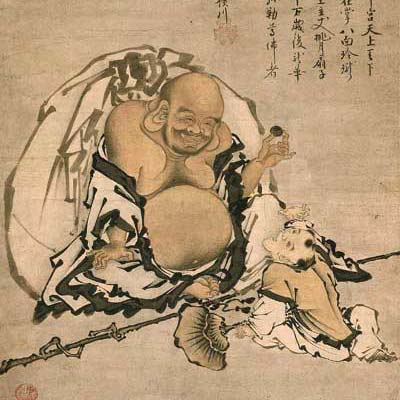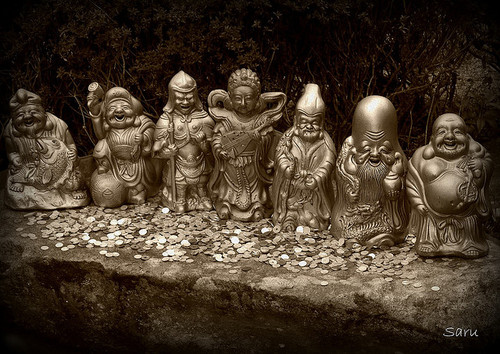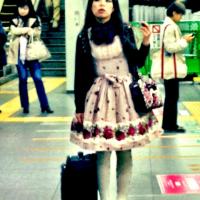The Japanese theological scene is as difficult and complex to follow as it is in any nation with several millennia of recorded history.
In terms of traditions relating to a given religion though, things in Japan could actually be a whole lot more confusing as two main religions play a major role in daily life – Shinto the native set of beliefs (that may or may not have some of its roots in Taoism) and Buddhism (imported from the mainland almost 1500 years ago).
In general Shintoism relates to the day-to-day trials and tribulations for many, if active practitioners – as well as to marriage ceremonies and issue relating to lucky and / or unlucky periods in an individual’s life. Buddhism, on the other hand is more about death (the vast majority of Japanese funeral services are performed alongside Buddhist rituals) and the afterlife, although, like Shintoism, it does serve as a well often dipped into by those seeking protection and aid in times of woe.
Imported from mainland Asia back in the earliest days of recorded history in the archipelago, Buddhism brought with it several concepts that have over the years made the leap into local beliefs, and none is perhaps better suited to highlight how interactive both have become than the pilgrimages made by millions each year around their nearest ‘Shichi Fukujin‘ course – a route that encompasses visits to Shinto shrines although Buddhism – as found in temples – is the basis for much of the history behind the story of Shichi Fukujin. These so called ‘Seven Lucky Gods’ – with ‘shichi’ being the Japanese term for ‘seven’ – offer various aspects of protection and aid.
A common depiction of the gods involves a boat called ‘takarabune’ in which the gods arrive as one as the New Year is welcomed in to offer blessings to the most deserving of their flock in a specific location. It is around this time of year, a popular time to visit temples and shrines anyway, that the Shichi Fukujin story really comes into its own and families, couples and lone walkers set off on foot around a set route in any of thousands of Shichi Fukujin spots around Japan. Many shrines now hosting the stone or less common wooden images of the gods provide stamps to prove you have made the trip and paid due homage, and it just wouldn’t be Japan were there not a plethora of Shichi Fukujin related souvenirs on sale – from delightful snacks to carvings and even soft toys in the shape of the gods individually or as a group – sailing along in their takarabune.
In traditional order, their names and services offered:

Hotei 布袋 – the plump god, always smiling God of Contentment & Happiness Chinese Name Budai or Putai
Said to be an incarnation of Miroku Bosatsu. Miroku in China is known as Miluo Fo (or as Miluo Pusa). Hotei known as the Fat Buddha or Laughing Buddha in the West. Reportedly based on a real person. Associated Virtue = Magnanimity.
The god of contentment and happiness, guardian of children, and patron of bartenders. Hotei 布袋 has a cheerful face and a big belly. He is supposedly based on an actual person, and is widely recognized outside of Japan as the Fat, Laughing Buddha. He carries a large cloth bag over his back (Nunobukuro 布袋, lit. = cloth bag), one that never empties, for he uses it to feed the poor and needy. It includes an inexhaustible cache of treasures, including food and drink. Indeed, the Japanese spelling of “Hotei” literally means “cloth bag.” He also holds a Chinese fan called an oogi 扇 (said to be a “wish giving” fan — in the distant past, this type of fan was used by the aristocracy to indicate to vassals that their requests would be granted). Hotei is most likely based on the itinerant 10th-century Chinese Buddhist monk and hermit Budaishi (d. 917), who is said to be an incarnation of Miroku Bodhisattva (Maitreya in Sanskrit).
Hotei is sometimes shown surrounded by a group of small children, romping and squealing in delight around his rotund shape. For many more details on Hotei, click here for story by Jennifer Polden.
In recent times, Hotei is also referred to as the patron saint of restaurateurs and bartenders. When one over eats and over drinks, one may sometimes jokingly attribute it to Hotei’s influence.

Jurojin – one of the Shichifukujin, or Seven Lucky Gods of Japan. He is the god of longevity, patron and protector of scholar. Jurojin is often seen holding a fan, and accompanied with a white crane. In the picture above of a finely carved netsuke, the crane is feeding on the leaf of a peach held in Jurojin’s left hand; both of which are symbols of longevity.
In Japan, Jurōjin (寿老人), also known as Gama, is one of the Seven Gods of Fortune or Shichifukujin, according to Taoist beliefs. He is the God of longevity. Jurōjin originated from the Chinese Taoist god, the Old Man of the South Pole. He is known as the immortal of the Northern Song dynasty (960 – 1127), and may have been a historical figure of the period. Jurōjin is identified as the personification of the Southern Polar Star. While paintings and statues of Jurōjin are considered auspicious, he never developed a following independent of the other deities Seven Gods of Fortune.
Jurōjin is often identified with Fukurokuju, another of the Several Gods of Fortune. In some accounts, the two are said to inhabit the same body. As such, the two are often confused.
Jurōjin walks with a staff and a fan. He is depicted as an old man of slight stature, and by tradition, less than 3 shaku (approximately 90 centimetres (35 in)). He is depicted with a long white beard and often a very tall, bald head. He has a scroll tied to his staff, on which is written the lifespan of all living things. The scroll is sometimes identified as a Buddhist sutra. The deer, a symbol of longevity, usually (but not always) accompanies him as a messenger, as do other long-lived animals such as the crane and the tortoise.
Jurōjin is a popular subject of Japanese ink wash paintings. He was introduced into the Japanese art tradition by Zen Buddhist painters, and depictions of Jurōjin span from the Muromachi period (1337 – 1573) through the Edo period (1603 – 1868). Artists who depicted Jurōjin as a subject includeSesshū (1420 – 1506), Sesson Shukei (1504 – 1589), Kanō Tan’yū (1602 – 1674), and Maruyama Ōkyo (1733 – 1795).

Fukurokuju – the god responsible for supplying personal happiness, riches and longevity to believers.
The name Fukurokuju is written with three Kanji (Characters) fuku, “happiness”;roku, “wealth”; and ju, “longevity”.
It has been theorized that he is a Japanese assimilation of the Chinese Three Star Gods (Fulushou) embodied in one deity. Most related in appearance to the Chinese star god Shou, he is the God of wisdom and longevity. According to some, before attaining divinity, he was a Chinese hermit of the Sung Dynasty and a reincarnation of the Taoist god Xuanwu. It is said that during his human incarnation, he was a sennin; a philosopher who could exist without eating food.
He is sometimes confused with Juroujin, who by some accounts is Fukurokuju’s grandson and by other accounts inhabits the same body as Fukurokuju.
Usually portrayed as being bald, with long whiskers, he is said to be an incarnation of the Southern Polestar. In many depictions, Fukurokuju has an abnormally high forehead. The sacred book tied to his staff either contains the lifespan of every person on earth or a magical scripture. He is accompanied by a crane and a turtle, which are considered to be symbols of longevity. He is also sometimes accompanied by a black deer (ancient legends say a deer turns black if it is over 2000 years old).
He is the only member of the Seven Lucky Gods credited with the ability to revive the dead.

Bishamonten – the god of the strong; originally military types.
Bishamonten (毘沙門天), or just Bishamon (毘沙門) is thought of as an armor-clad god of warfare or warriors and a punisher of evildoers – a view that is at odds with the more pacific Buddhist king described above. Bishamon is portrayed holding a spear in one hand and a small pagoda in the other hand, the latter symbolizing the divine treasure house, whose contents he both guards and gives away. In Japanese folklore, he is one of the Japanese Seven Gods of Fortune.
Bishamon is also called Tamonten (多聞天), meaning “listening to many teachings” because he is seen as the guardian of the places where Buddhapreaches. He is believed to live halfway down Mount Sumeru.
Benzaiten – a female Benzaiten (弁才天, 弁財天) is the Japanese name for the Hindu goddess Saraswati. Worship of Benzaiten arrived in Japan during the 6th through 8th centuries, mainly via the Chinese translations of the Sutra of Golden Light, which has a section devoted to her. She is also mentioned in the Lotus Sutra and often depicted holding a biwa, a traditional Japanese lute, in contrast to Saraswati who holds a stringed instrument known as a veena. Benzaiten is a highly syncretic entity with both a Buddhist and a Shinto side.
Referred to as Sarasvatî Devî in Sanskrit (meaning “Goddess Saraswati”), Benzaiten is the goddess of everything that flows: water, words, speech, eloquence, music and by extension, knowledge. The original characters used to write her name read “Biancaitian” in Chinese and “Bensaiten” in Japanese (辯才天) and reflect her role as the goddess of eloquence. Because the Sutra of Golden Light promised protection of the state, in Japan she became a protector-deity, at first of the state and then of people. Lastly, she became one of the Seven Gods of Fortune when the Sino-Japanese characters used to write her name changed to 弁財天 (Benzaiten), emphasizing her role in bestowing monetary fortune. Sometimes she is called Bentenalthough this name usually refers to the god Brahma.
In the Rig-Veda (6.61.7) Sarasvati is credited with killing the three-headed Vritra also known as Ahi (“snake”). Vritra is also strongly associated with rivers, as is Sarasvati. This is probably one of the sources of Sarasvati/Benzaiten’s close association with snakes and dragons in Japan. She is enshrined on numerous locations throughout Japan; for example, the Enoshima Island in Sagami Bay, the Chikubu Island in Lake Biwa and theItsukushima Island in Seto Inland Sea (Japan’s Three Great Benzaiten Shrines); and she and a five-headed dragon are the central figures of theEnoshima Engi, a history of the shrines on Enoshima written by the Japanese Buddhist monk Kōkei (皇慶) in AD 1047. According to Kōkei, Benzaiten is the third daughter of the dragon-king of Munetsuchi (無熱池; literally “lake without heat”), known in Sanskrit as Anavatapta, the lake lying at the center of the world according to an ancient Buddhist cosmological view.
Benzaiten as a kami
Benzaiten is a female kami to Shinto with the name Ichikishima-hime-no-mikoto (市杵島姫命?).[1] Also, she is believed by Tendai Buddhism to be the essence of kami Ugajin, whose effigy she sometimes carries on her head together with a torii (see photo above).[2] As a consequence, she is sometimes also known as Uga (宇賀?) Benzaiten or Uga Benten. Shrine pavilions called eitherBenten-dō or Benten-sha (弁天社?), or even entire Shinto shrines can be dedicated to her, as in the case of Kamakura’s Zeniarai Benzaiten Ugafuku Shrine or Nagoya’s Kawahara Shrine.

Daikokuten – another bringer of wealth, but for those in the business world. His name literally means “Great Black Deva”
God of Earth, Agriculture, Rice, Farmers, the Kitchen, & Wealth. Shinto Association = Ōkuninushi no Mikoto 大国主命 Associated Virtue = Fortune
Originally a Hindu warrior deity named Mahākāla (an emanation ofSiva; transliterated Makakara 摩訶迦羅), but later adopted into the Buddhist pantheon and appearing by at least China’s Sui 隋 dynasty (581-618) in Buddhist texts.
Daikokuten 大黒天 or Daikoku 大黒 is widely known in Japan as the happy-looking god of wealth, farmers, food, and good fortune, although in earlier centuries he was considered a fierce warrior deity. The oldest extant image of Daikokuten in Japan is dated to the late Heian period (794-1185) and installed at Kanzeonji Temple 観世音寺 (Fukuoka prefecture). The statue depicts the deity with a fierce expression, reminding us of his Hindu origin as a war god, as does the late-Heian sculpture of Daikoku at Kongōrinji Temple 金剛輪寺 (Shiga prefecture), which shows him dressed in armor.
However, since the 15th century, Japanese artwork of this deity starts showing him as a cheerful and pudgy deity wearing a peasant’s hat (called Daikoku-zukin 大黒頭巾) and standing on bales of rice (tawara 俵), carrying a large sack of treasure slung over his shoulder and holding a small magic mallet. There are other forms, including a female form, but in Japan, the god is invariably shown standing on two bales of rice holding his magic mallet and treasure sack. Images, paintings, and other artwork of Daikokuten can be found everywhere in modern Japan, showing him alone, paired with Ebisu (considered his son in many traditions), or grouped with the Seven Lucky Gods. He appears on posters, key chains, mobile-phone accessories, toys for children, and many other commercial goods.
Daikoku is also considered a deity of the kitchen and a provider of food, and images of him can still be found in the kitchens of monasteries and private homes. This tradition is thought to have come from India and China, were images of Mahākāla (Daikoku’s Sanskrit name) were placed in monastery kitchens to provide for the nourishment of the monks. In Japan, the practice is thought to have been introduced on Mt. Hiei 比叡 in the 9th century by Saichō 最澄 (767-822), the founder of Japan’s Tendai sect. Saichō is also credited with introducing a three-headed form of Daikoku known as Sanmen Daikoku. In addition, says the Buddhism (Flammarion Iconographic Guides)
, “The main pillar of a house in the traditional Japanese style assumes the name of Daikoku-bashira 大黒柱 or ‘pillar of Daikoku,’ meaning ‘pillar of luck and wealth.’
Ebisu – often seen holding a large fish. Ebisu is the only originally Japanese god in the bunch, perhaps not surprising, given the fishing roots of the ancient Japanese.
Ebisu (恵比須, 恵比寿, 夷, 戎), also transliterated Yebisu (ゑびす – see historical kana orthography) or called Hiruko (蛭子) or Kotoshiro-nushi-no-kami (事代主神), is the Japanese god of fishermen, luck, and workingmen, as well as the guardian of the health of small children.
In medieval times, Ebisu’s origin came to be tied together with that of Hiruko (蛭子) – the first child of Izanagi and Izanami, born without bones (or, in some stories, without arms and legs) due to his mother’s transgression during the marriage ritual. Hiruko struggled to survive but, as he could not stand, he was cast to the sea in a boat of reeds before his third birthday.[1] The story tells that Hiruko eventually washed ashore—possibly in Ezo (蝦夷, ancient Hokkaidō)—and was cared for by the Ainu Ebisu Saburo (戎三郎). It is however believed that Ebisu first arose as a god among fishermen, and that his origin as Hiruko was a much later conception, after the worship of him had spread to merchants and others. It is also theorized that he was originally a god known as “Kotoronushi no Mikoto,” son of Ōkuninushi.
This weak child overcame many hardships, grew legs (and, presumably, the rest of his skeletal structure) at the age of three, and became the god Ebisu. He remains slightly crippled and deaf, but mirthful and auspicious nonetheless (hence the title, “The Laughing God”). He is often depicted wearing a tall hat—the Kazaori Eboshi (風折烏帽子)—holding a rod and a large red sea bream or sea bass. Jellyfish are also associated with the god and the fugu restaurants of Japan will often incorporate Ebisu in their motif.













